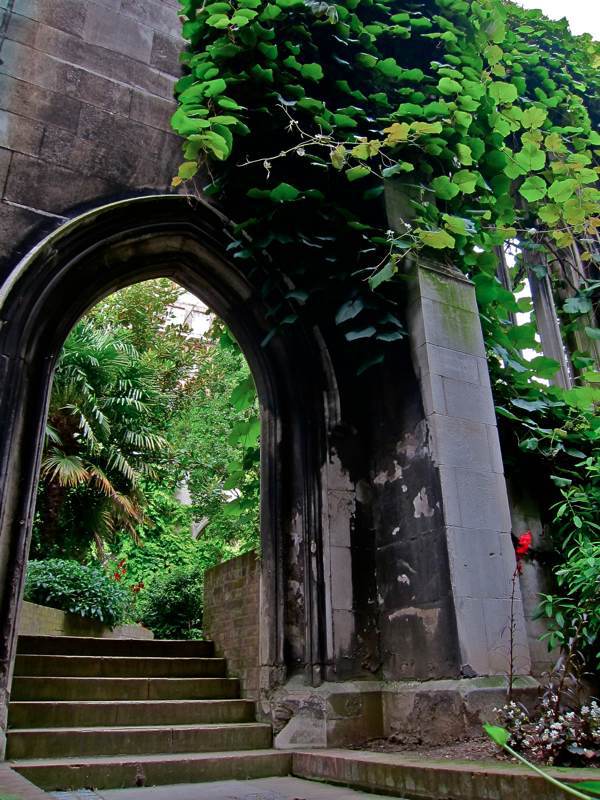Famously many of the iron and steel railings in the U.K. were removed and melted down to help the war effort in WW2. Whether a large city park or a private residence, chances are if there was a traditional style railing or gate then it would have been melted down and recycled into things like Spitfires, guns, ships or tanks.
These old iron railings were very expensive to replace and both money and metal were scarce commodities in the 1940s and 50s. However, life moved on and people needed new fencing, particularly in the social housing estates in East and South London that were sprouting from the ashes to house the homeless and refugees.
As it happened, there just happened to be a ready to hand and free replacement, ARP stretchers. These stretchers were originally made so that Air Raid Protection officers could carry injured people during bombing attacks in the Blitz. Over 600,000 stretchers were built from steel to enable them to be easily disinfected in highly-feared gas attacks.

When the war ended there was a large surplus of stretchers and many of London’s housing estates had had their original railings removed to serve the war effort. The LCC set about replacing them through clever re-use of the ARP stretchers.
However, over the years many have been replaced either with more purpose built fencing or as the original post-war housing has been replaced with better quality residences. As such, the stretcher fences that I vaguely remember seeing as a boy are now disappearing fast and a campaign has been launched to protect metal fences in south London made from WW2 stretchers once used to carry thousands of wounded civilians in the Blitz.

The so-called ‘stretcher fences’ can be found on estates in Peckham, Brixton, Deptford, Oval and East London.

Local historians claim hundreds of thousands of Londoners walk past the fences every day completely oblivious to their “fascinating history”, and now they are at risk of being ripped down and replaced.
Campaigners are hoping to promote awareness of the fences so they can raise money to conserve them and install plaques.
Conservation manager Rosie Shaw recently told the London press “I had been talking about doing something for a while and then a lot got ripped out at East Dulwich Estate in Dog Kennel Hill a couple of weeks ago.
“A lot of them badly need some conservation or councils will have to replace them.
“I think it would be wonderful if more people knew about them and could engage with them. Anyone who we tell gets really excited and it’s a really fascinating social part of our history.”
She added: “It’s quite hard to think of physical reminders of the Second World War. It’s extraordinary that they are still here.”
The stretcher fences are recognisable thanks to two indents at each end, used to raise the stretcher slightly off the ground.

More than 600,000 were built during WW2 so that Air Raid Protection officers could carry injured people during German bomb raids.
They were made from steel so that they could be easily washed down after use.
Peter Eaves, of the Museum of the Order of St John, which has an original stretcher, states: “At the end of the war, the authorities were left with an enormous stockpile of stretchers.
“Railings across the capital had been removed at the beginning of the war in an effort to fuel the desperate production of munitions and war materials.
“The ARP stretchers were a handy expedient. Across London, particularly in the south-east and east, the stretchers were welded vertically together, complete with their kinked poles and wire mesh middle and fixed into position.”

For more information on the campaign to save stretcher fences or to report any that you might see on your daily walk then why not visit the official website.
If you’d like to visit some unusual WW2 locations in London with me then check out our 2 WW2 tours with Ye Olde England Tours.


Secret Gardens & Sanctuary Walk

I don’t know when I will be in London but will certainly pass your info to people I know who would be visiting this city.
LikeLike
Oh, goodness, that’s a fascinating story of the fences. And it is the sort of thing one might see daily for decades and never suspect had a story to it.
LikeLike
That is such a fab thing! At first glance the fence looks bent but then you notice the uniformity. 🙂
LikeLike
Reblogged this on Pete's Favourite Things and commented:
I knew about the removal of railings during the way. My Grandmothers house had a wall which still contained the bases where the railings had been sawn off. But I had not heard about the use of old stretchers post war as a replacement. What an excellent example of re-cycling
LikeLiked by 1 person
Reblogged this on sed30's Blog and commented:
A piece of history
LikeLike
How amazing! You’d never see anything like that done today, we seem to have lost out ability to repurpose things.
LikeLike